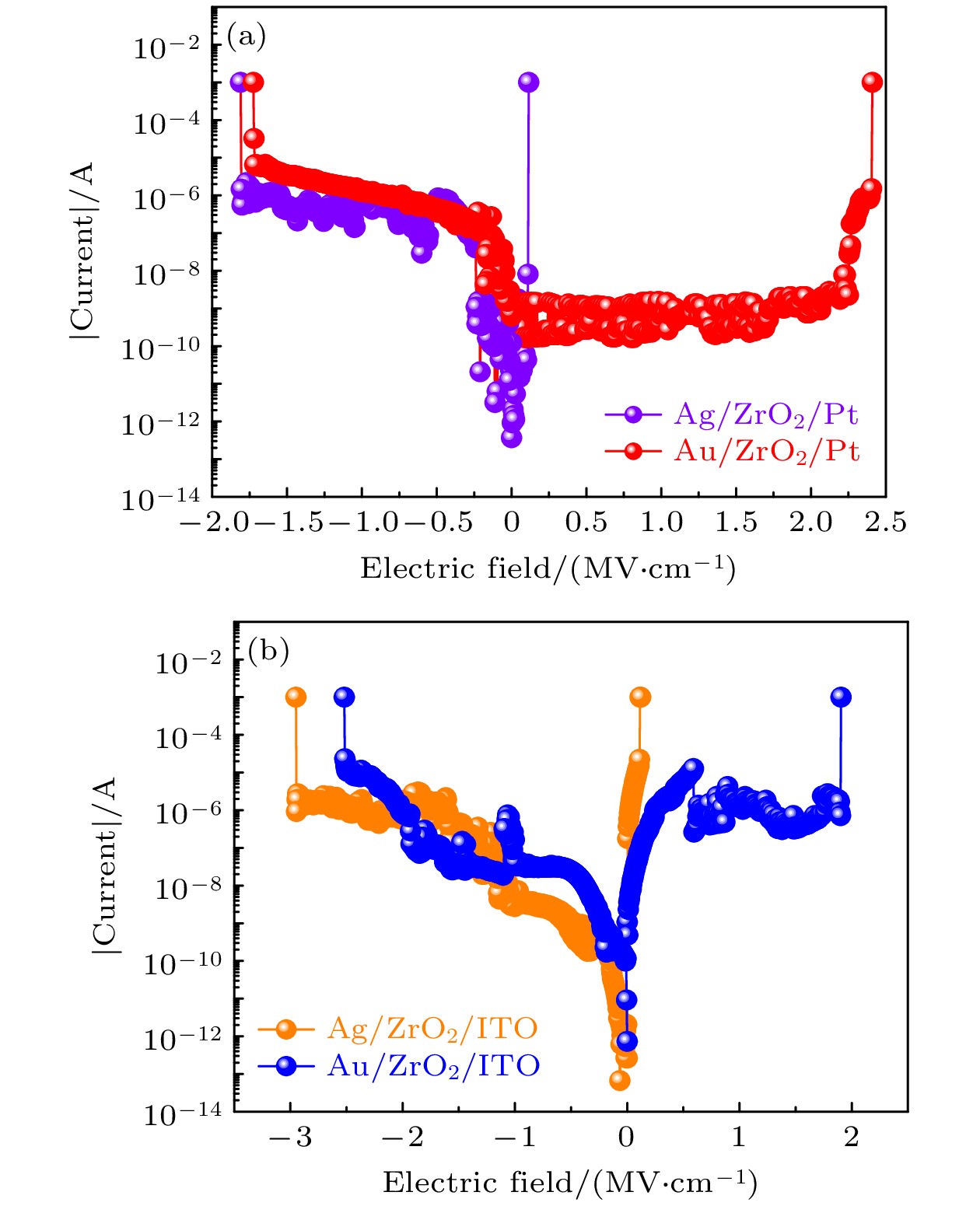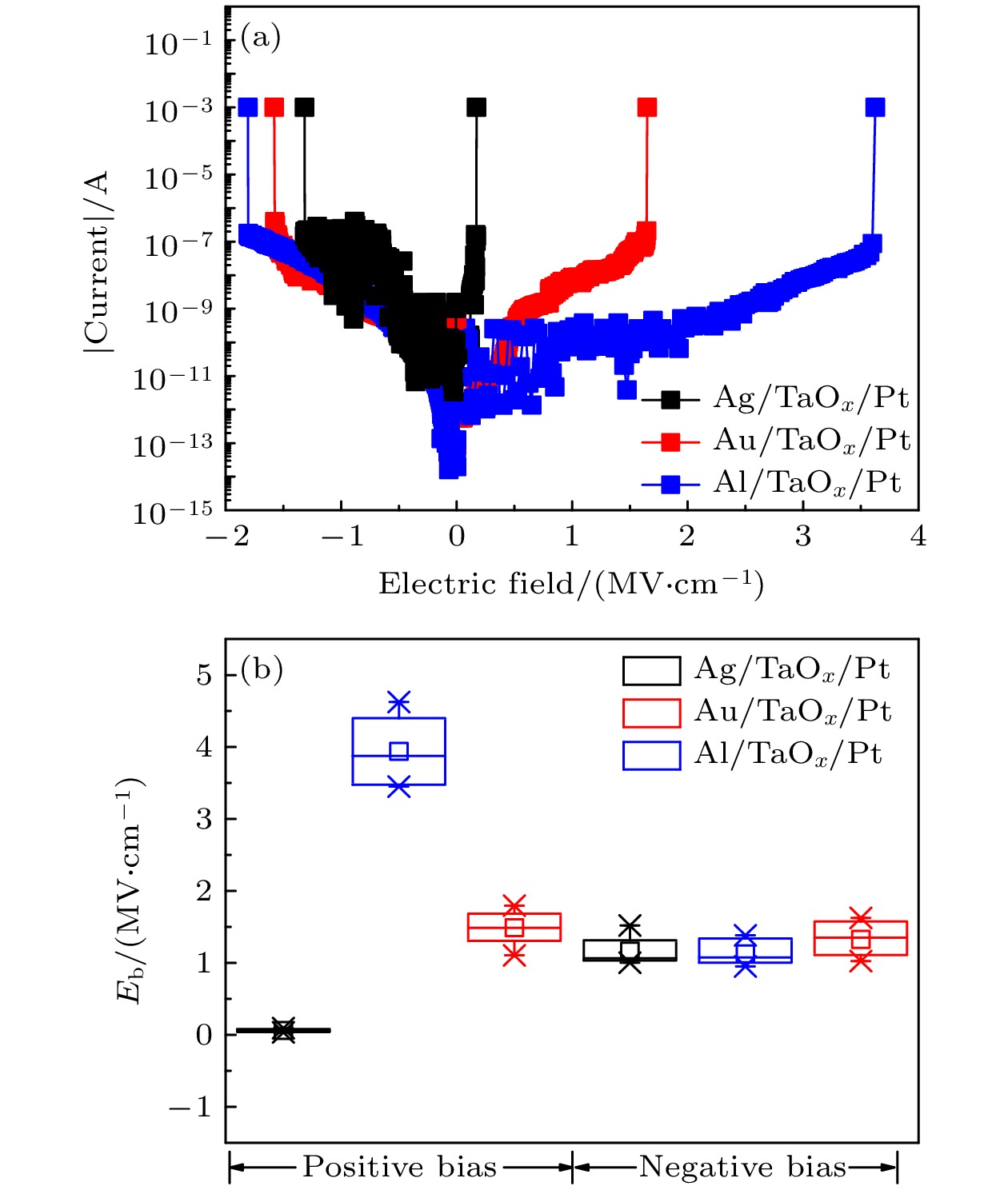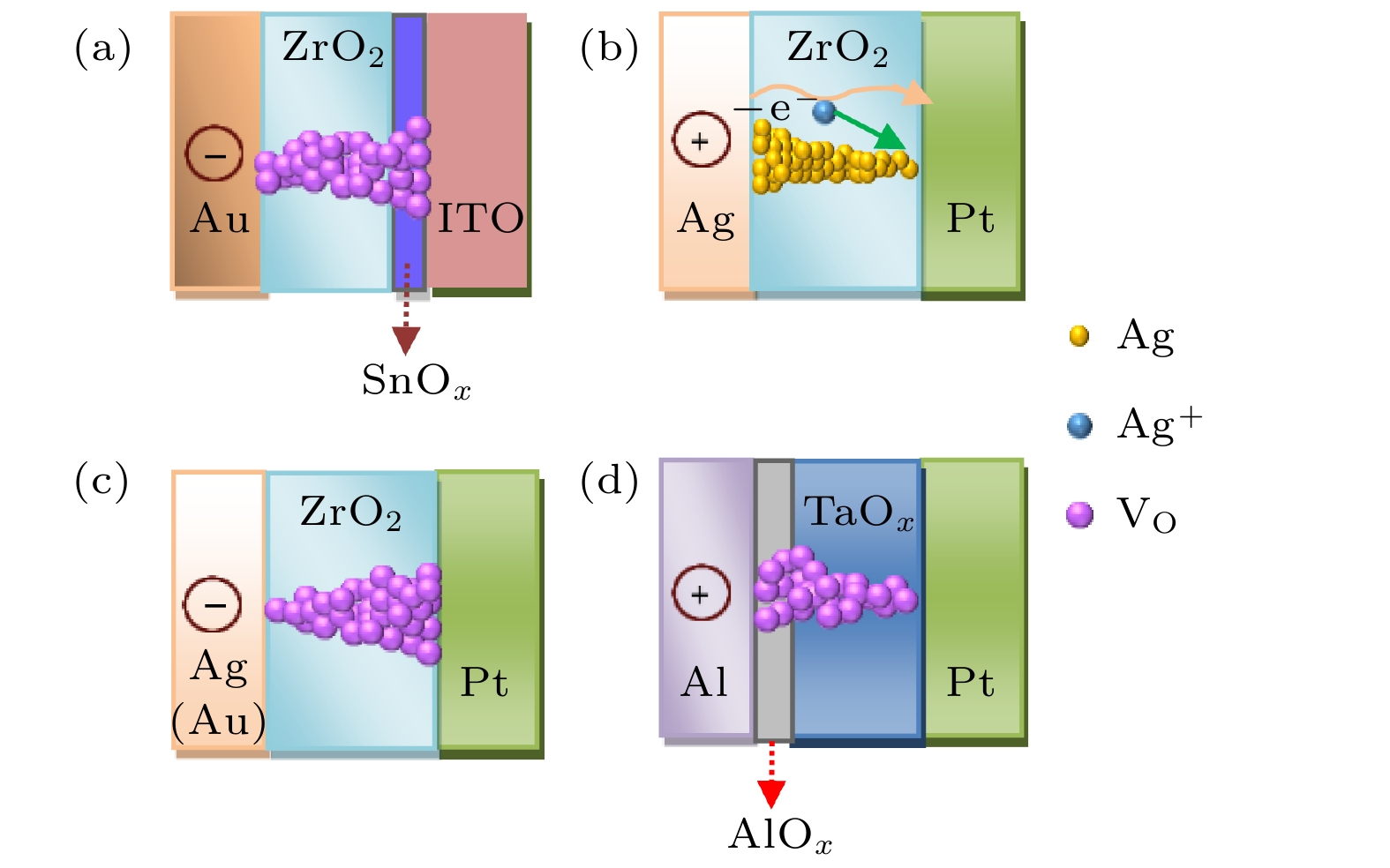-
忆阻器和能量存储电容器具有相同的三明治结构, 然而两个器件需要的操作电压有明显差异, 因此在同一个器件中, 研究操作电压的影响因素并对操作电压进行调控, 实现器件在不同领域的应用是十分必要的一个工作. 本文利用反应磁控溅射技术在ITO导电玻璃、Pt/Si基底上生长了多晶ZrO2和非晶TaOx薄膜, 选用不同金属材料Au, Ag和Al用作上电极构建了多种金属/氧化物介质/金属三明治结构的电容器, 研究了器件在不同偏压极性下的击穿强度. 结果发现: 底电极是ITO的ZrO2基电容器在负偏压下的击穿电场比Pt电极器件稍大. 不管底电极是ITO还是Pt, Ag作为上电极时器件的击穿强度均存在明显的偏压极性依赖性, 正偏压下的击穿电场减小了一个数量级; 相反, 在Al作为上电极的Al/TaOx/Pt器件中, 正向偏压比负向偏压下的击穿电场增加了近2倍. 上述器件的不同击穿行为分别可以由氧化物电极和介质界面层间氧的迁移和重排、电化学活性金属电极的溶解迁移和还原以及化学活性金属电极与氧化物界面的氧化还原反应来解释. 该实验结果对有不同操作电压要求的器件, 如忆阻器和介质储能电容器等在器件设计和操作方面具有指导意义.
The memristors and the energy storage capacitors have the same sandwich structure, but the operating voltages required by the two devices are significantly different. Therefore, in the same device, it is necessary to study the influencing factors of operating voltage and adjust the operating voltage of the devices to realize the applications of the device in diverse fields. The polycrystalline ZrO2 and amorphous TaOx thin films are deposited on ITO conductive glass and Pt/Si substrates by reactive magnetron sputtering technology. Au, Ag and Al metal materials are selected as the top electrodes to construct a variety of metal/insulator/metal sandwich capacitors. The breakdown strengths of these devices under different bias polarities are studied. The results demonstrate that the breakdown strength is slightly larger for the ZrO2 based capacitor with ITO as the bottom electrode than for the Pt electrode device under negative bias. The breakdown electric field of the device with Ag as the top electrode shows obvious dependence on bias polarity, no matter whether the bottom electrode is ITO or Pt. The breakdown strength is reduced by more than an order of magnitude under a positive bias (2.13 MV/cm) compared with under a negative bias (0.17 MV/cm) of Ag/ZrO2/ITO device. The breakdown strength of the Al/TaOx/Pt device is enhanced under the forward bias (3.6 MV/cm), contrary to the Ag electrode device, which is nearly twice higher than the breakdown electric field under the negative bias (1.81 MV/cm). The different breakdown behaviors of the above devices can be explained by the migration and rearrangement of oxygen between the oxide electrode and the dielectric interface layer; the dissolution, migration and reduction of the electrochemically active metal electrode; and the redox reaction between the chemically active metal electrode and the oxide dielectric interface. The ZrO2 based capacitor with ITO electrode undergoes a redox reaction of Sn4+ in the ITO under negative bias, forming an insulating layer at the interface between the dielectric layer and the ITO electrode, which contributes a larger breakdown electric field. In addition, the electrochemical metallization process happens to the Ag electrode device under positive bias, and the breakdown electric field is smaller than negative bias due to the large diffusion coefficient of Ag ions in the film, while breakdown is dominated by the defect characteristics of the dielectric film under negative bias. The Al/TaOx/Pt devices can form AlOx oxide layer under positive bias, spontaneously, which can inhibit the leakage current, and also act as a series resistance to disperse part of the voltage and enhance the breakdown voltage of the device. The experimental results have guided significance in designing and operating the devices with different operating voltage requirements, such as memristors and dielectric energy storage capacitors. -
Keywords:
- oxide films /
- electrode materials /
- bias polarity /
- breakdown mechanism /
- memristors /
- capacitors
[1] Chua L 1971 IEEE Trans. Circuit Theory 18 507
 Google Scholar
Google Scholar
[2] Hao X 2013 J. Adv. Dielectr. 3 1330001
 Google Scholar
Google Scholar
[3] Palneedi H, Peddigari M, Hwang G T, Jeong D Y, Ryu J 2018 Adv. Funct. Mater. 28 1803665
 Google Scholar
Google Scholar
[4] Zheng T, Wu J, Xiao D, Zhu J 2018 Prog. Mater Sci. 98 552
 Google Scholar
Google Scholar
[5] Wang Y, Jie W, Yang C, Wei X, Hao J 2019 Adv. Funct. Mater. 29 1808118
 Google Scholar
Google Scholar
[6] Wang Y, Hu L, Wei X, Zhuge F 2020 Appl. Phys. Lett. 116 221602
 Google Scholar
Google Scholar
[7] Choi J, Park S, Lee J, Hong K, Kim D H, Moon C W, Park G D, Suh J, Hwang J, Kim S Y, Jung H S, Park N G, Han S, Nam K T, Jang H W 2016 Adv. Mater. 28 6562
 Google Scholar
Google Scholar
[8] Hu L, Fu S, Chen Y, Cao H, Liang L, Zhang H, Gao J, Wang J, Zhuge F 2017 Adv. Mater. 29 1606927
 Google Scholar
Google Scholar
[9] Guo J, Wang L, Liu Y, Zhao Z, Zhu E, Lin Z, Wang P, Jia C, Yang S, Lee S J, Huang W, Huang Y, Duan X 2020 Matter 2 965
 Google Scholar
Google Scholar
[10] Guo X, Wang Q, Lü X, Yang H, Sun K, Yang D, Zhang H, Hasegawa T, He D 2020 Nanoscale 12 4320
 Google Scholar
Google Scholar
[11] Liu Y, Ye C, Chang K C, Li L, Jiang B, Xia C, Liu L, Zhang X, Liu X, Xia T, Peng Z, Cao G, Cheng G, Ke S, Wang J 2020 Small 16 2004619
 Google Scholar
Google Scholar
[12] McPherson J W, Jinyoung K, Shanware A, Mogul H, Rodriguez J 2003 IEEE Trans. Electron Devices 50 1771
 Google Scholar
Google Scholar
[13] Yang L, Kong X, Li F, Hao H, Cheng Z, Liu H, Li J F, Zhang S 2019 Prog. Mater Sci. 102 72
 Google Scholar
Google Scholar
[14] Pan F, Gao S, Chen C, Song C, Zeng F 2014 Mater. Sci. Eng. R. 83 1
 Google Scholar
Google Scholar
[15] 庞华, 邓宁 2014 物理学报 63 147301
 Google Scholar
Google Scholar
Pang H, Deng N 2014 Acta Phys. Sin. 63 147301
 Google Scholar
Google Scholar
[16] Liu Q, Sun J, Lü H, Long S, Yin K, Wan N, Li Y, Sun L, Liu M 2012 Adv. Mater. 24 1844
 Google Scholar
Google Scholar
[17] Liu S, Lu N, Zhao X, Xu H, Banerjee W, Lü H, Long S, Li Q, Liu Q, Liu M 2016 Adv. Mater. 28 10623
 Google Scholar
Google Scholar
[18] Li Q, Qiu L, Wei X, Dai B, Zeng H 2016 Sci. Rep. 6 29347
 Google Scholar
Google Scholar
[19] Tian B, Nukala P, Hassine M B, Zhao X, Wang X, Shen H, Wang J, Sun S, Lin T, Sun J, Ge J, Huang R, Duan C, Reiss T, Varela M, Dkhil B, Meng X, Chu J 2017 Phys. Chem. Chem. Phys. 19 16960
 Google Scholar
Google Scholar
[20] Gao W, Yao M, Yao X 2017 Ceram. Int. 43 13069
 Google Scholar
Google Scholar
[21] Gao W, Yao M, Yao X 2018 ACS Appl. Mater. Interfaces 10 28745
 Google Scholar
Google Scholar
[22] Hou C, Huang W, Zhao W, Zhang D, Yin Y, Li X 2017 ACS Appl. Mater. Interfaces 9 20484
 Google Scholar
Google Scholar
[23] Panda D, Tseng T Y 2013 Thin Solid Films 531 1
 Google Scholar
Google Scholar
[24] Kudoh Y, Akami K, Matsuya Y 1999 Synth. Met. 102 973
 Google Scholar
Google Scholar
[25] Matsuhashi H, Nishikawa S 1994 Jpn. J. Appl. Phys. 33 1293
 Google Scholar
Google Scholar
[26] Atanassova E, Paskaleva A 2007 Microelectron. Reliab. 47 913
 Google Scholar
Google Scholar
[27] Lee M J, Lee C B, Lee D, Lee S R, Chang M, Hur J H, Kim Y B, Kim C J, Seo D H, Seo S, Chung U I, Yoo I K, Kim K 2011 Nat. Mater. 10 625
 Google Scholar
Google Scholar
[28] Wu M C, Wu T H, Tseng T Y 2012 J. Appl. Phys. 111 014505
 Google Scholar
Google Scholar
[29] Liu Q, Long S, Wang W, Tanachutiwat S, Li Y, Wang Q, Zhang M, Huo Z, Chen J, Liu M 2010 IEEE Electron Device Lett. 31 1299
 Google Scholar
Google Scholar
[30] Li Y, Long S, Zhang M, Liu Q, Shao L, Zhang S, Wang Y, Zuo Q, Liu S, Liu M 2009 IEEE Electron Device Lett. 31 117
 Google Scholar
Google Scholar
[31] Li C, Wang F, Zhang J, She Y, Zhang Z, Liu L, Liu Q, Hao Y, Zhang K 2020 ECS J. Solid State Sci. Technol 9 041005
 Google Scholar
Google Scholar
[32] Atanassova E, Spassov D, Paskaleva A 2006 Microelectron. Eng. 83 1918
 Google Scholar
Google Scholar
[33] Kindsmüller A, Meledin A, Mayer J, Waser R, Wouters D J 2019 Nanoscale 11 18201
 Google Scholar
Google Scholar
[34] Yuan X C, Tang J L, Zeng H Z, Wei X H 2014 Nanoscale Res. Lett. 9 268
 Google Scholar
Google Scholar
[35] Ye C, Zhan C, Tsai T M, Chang K C, Chen M C, Chang T C, Deng T, Wang H 2014 Appl. Phys. Express 7 034101
 Google Scholar
Google Scholar
[36] Zhang J, Wang F, Li C, Shan X, Liang A, Hu K, Li Y, Liu Q, Hao Y, Zhang K 2020 Appl. Surf. Sci. 526 146723
 Google Scholar
Google Scholar
[37] Wu M C, Ting Y H, Chen J Y, Wu W W 2019 Adv. Sci. 6 1902363
 Google Scholar
Google Scholar
[38] Kuo C C, Chen I C, Shih C C, Chang K C, Huang C H, Chen P H, Chang T, Tsai T M, Chang J S, Huang J C 2015 IEEE Electron Device Lett. 36 1321
 Google Scholar
Google Scholar
-
图 6 器件在施加偏压下的击穿机理示意图 (a)负偏压下的Au/ZrO2/ITO器件; (b), (c) 正负偏压下的Ag/ZrO2/Pt器件; (d) 正偏压下的Al/TaOx/Pt器件
Fig. 6. Schematic diagrams of the breakdown mechanisms of the devices under different applied biases: (a) The Au/ZrO2/ITO device under negative bias; (b), (c) Ag/ZrO2/Pt devices under positive and negative biases, respectively; (d) the Al/TaOx/Pt device under positive bias.
-
[1] Chua L 1971 IEEE Trans. Circuit Theory 18 507
 Google Scholar
Google Scholar
[2] Hao X 2013 J. Adv. Dielectr. 3 1330001
 Google Scholar
Google Scholar
[3] Palneedi H, Peddigari M, Hwang G T, Jeong D Y, Ryu J 2018 Adv. Funct. Mater. 28 1803665
 Google Scholar
Google Scholar
[4] Zheng T, Wu J, Xiao D, Zhu J 2018 Prog. Mater Sci. 98 552
 Google Scholar
Google Scholar
[5] Wang Y, Jie W, Yang C, Wei X, Hao J 2019 Adv. Funct. Mater. 29 1808118
 Google Scholar
Google Scholar
[6] Wang Y, Hu L, Wei X, Zhuge F 2020 Appl. Phys. Lett. 116 221602
 Google Scholar
Google Scholar
[7] Choi J, Park S, Lee J, Hong K, Kim D H, Moon C W, Park G D, Suh J, Hwang J, Kim S Y, Jung H S, Park N G, Han S, Nam K T, Jang H W 2016 Adv. Mater. 28 6562
 Google Scholar
Google Scholar
[8] Hu L, Fu S, Chen Y, Cao H, Liang L, Zhang H, Gao J, Wang J, Zhuge F 2017 Adv. Mater. 29 1606927
 Google Scholar
Google Scholar
[9] Guo J, Wang L, Liu Y, Zhao Z, Zhu E, Lin Z, Wang P, Jia C, Yang S, Lee S J, Huang W, Huang Y, Duan X 2020 Matter 2 965
 Google Scholar
Google Scholar
[10] Guo X, Wang Q, Lü X, Yang H, Sun K, Yang D, Zhang H, Hasegawa T, He D 2020 Nanoscale 12 4320
 Google Scholar
Google Scholar
[11] Liu Y, Ye C, Chang K C, Li L, Jiang B, Xia C, Liu L, Zhang X, Liu X, Xia T, Peng Z, Cao G, Cheng G, Ke S, Wang J 2020 Small 16 2004619
 Google Scholar
Google Scholar
[12] McPherson J W, Jinyoung K, Shanware A, Mogul H, Rodriguez J 2003 IEEE Trans. Electron Devices 50 1771
 Google Scholar
Google Scholar
[13] Yang L, Kong X, Li F, Hao H, Cheng Z, Liu H, Li J F, Zhang S 2019 Prog. Mater Sci. 102 72
 Google Scholar
Google Scholar
[14] Pan F, Gao S, Chen C, Song C, Zeng F 2014 Mater. Sci. Eng. R. 83 1
 Google Scholar
Google Scholar
[15] 庞华, 邓宁 2014 物理学报 63 147301
 Google Scholar
Google Scholar
Pang H, Deng N 2014 Acta Phys. Sin. 63 147301
 Google Scholar
Google Scholar
[16] Liu Q, Sun J, Lü H, Long S, Yin K, Wan N, Li Y, Sun L, Liu M 2012 Adv. Mater. 24 1844
 Google Scholar
Google Scholar
[17] Liu S, Lu N, Zhao X, Xu H, Banerjee W, Lü H, Long S, Li Q, Liu Q, Liu M 2016 Adv. Mater. 28 10623
 Google Scholar
Google Scholar
[18] Li Q, Qiu L, Wei X, Dai B, Zeng H 2016 Sci. Rep. 6 29347
 Google Scholar
Google Scholar
[19] Tian B, Nukala P, Hassine M B, Zhao X, Wang X, Shen H, Wang J, Sun S, Lin T, Sun J, Ge J, Huang R, Duan C, Reiss T, Varela M, Dkhil B, Meng X, Chu J 2017 Phys. Chem. Chem. Phys. 19 16960
 Google Scholar
Google Scholar
[20] Gao W, Yao M, Yao X 2017 Ceram. Int. 43 13069
 Google Scholar
Google Scholar
[21] Gao W, Yao M, Yao X 2018 ACS Appl. Mater. Interfaces 10 28745
 Google Scholar
Google Scholar
[22] Hou C, Huang W, Zhao W, Zhang D, Yin Y, Li X 2017 ACS Appl. Mater. Interfaces 9 20484
 Google Scholar
Google Scholar
[23] Panda D, Tseng T Y 2013 Thin Solid Films 531 1
 Google Scholar
Google Scholar
[24] Kudoh Y, Akami K, Matsuya Y 1999 Synth. Met. 102 973
 Google Scholar
Google Scholar
[25] Matsuhashi H, Nishikawa S 1994 Jpn. J. Appl. Phys. 33 1293
 Google Scholar
Google Scholar
[26] Atanassova E, Paskaleva A 2007 Microelectron. Reliab. 47 913
 Google Scholar
Google Scholar
[27] Lee M J, Lee C B, Lee D, Lee S R, Chang M, Hur J H, Kim Y B, Kim C J, Seo D H, Seo S, Chung U I, Yoo I K, Kim K 2011 Nat. Mater. 10 625
 Google Scholar
Google Scholar
[28] Wu M C, Wu T H, Tseng T Y 2012 J. Appl. Phys. 111 014505
 Google Scholar
Google Scholar
[29] Liu Q, Long S, Wang W, Tanachutiwat S, Li Y, Wang Q, Zhang M, Huo Z, Chen J, Liu M 2010 IEEE Electron Device Lett. 31 1299
 Google Scholar
Google Scholar
[30] Li Y, Long S, Zhang M, Liu Q, Shao L, Zhang S, Wang Y, Zuo Q, Liu S, Liu M 2009 IEEE Electron Device Lett. 31 117
 Google Scholar
Google Scholar
[31] Li C, Wang F, Zhang J, She Y, Zhang Z, Liu L, Liu Q, Hao Y, Zhang K 2020 ECS J. Solid State Sci. Technol 9 041005
 Google Scholar
Google Scholar
[32] Atanassova E, Spassov D, Paskaleva A 2006 Microelectron. Eng. 83 1918
 Google Scholar
Google Scholar
[33] Kindsmüller A, Meledin A, Mayer J, Waser R, Wouters D J 2019 Nanoscale 11 18201
 Google Scholar
Google Scholar
[34] Yuan X C, Tang J L, Zeng H Z, Wei X H 2014 Nanoscale Res. Lett. 9 268
 Google Scholar
Google Scholar
[35] Ye C, Zhan C, Tsai T M, Chang K C, Chen M C, Chang T C, Deng T, Wang H 2014 Appl. Phys. Express 7 034101
 Google Scholar
Google Scholar
[36] Zhang J, Wang F, Li C, Shan X, Liang A, Hu K, Li Y, Liu Q, Hao Y, Zhang K 2020 Appl. Surf. Sci. 526 146723
 Google Scholar
Google Scholar
[37] Wu M C, Ting Y H, Chen J Y, Wu W W 2019 Adv. Sci. 6 1902363
 Google Scholar
Google Scholar
[38] Kuo C C, Chen I C, Shih C C, Chang K C, Huang C H, Chen P H, Chang T, Tsai T M, Chang J S, Huang J C 2015 IEEE Electron Device Lett. 36 1321
 Google Scholar
Google Scholar
计量
- 文章访问数: 8990
- PDF下载量: 125
- 被引次数: 0














 下载:
下载:





